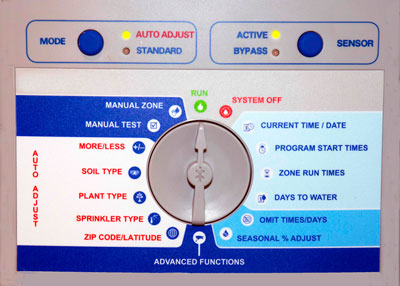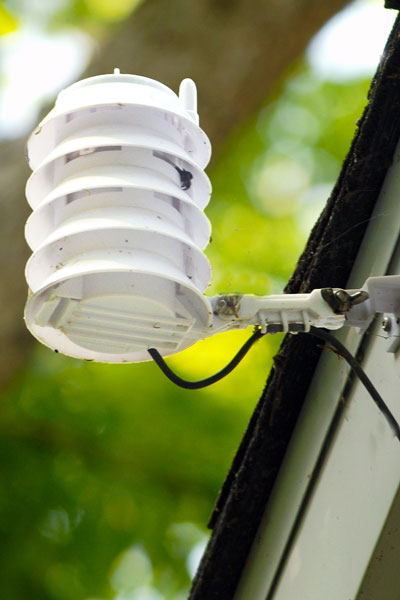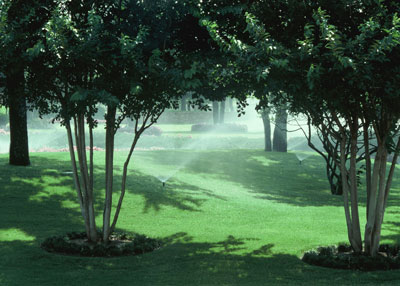“Smart Controllers” for Sprinklers

It takes someone familiar with the settings available for smart controllers to get maximum benefit from it.
There was a time when an automatic sprinkler system allowed you to set the weekdays, the time of day, and the number of minutes each station would run. Those of us who grew up dragging hoses thought that was just the greatest thing ever.
But those sprinklers too often were left with settings to water every station the same amount of time (often 20 minutes), at the same time (usually early morning hours), and on the same days of the week (often every day). Homeowners never gave the clocks another look until something went wrong.
Then came the temperature sensors so the system would be locked down when the temperature was dropping toward freezing. That was a good thing, but it wasn’t a huge move.
Jump ahead to the past six or eight years. Manufacturers have been providing “smart controllers” that have at least a relative sense of your landscape and your locale, and that adjust watering times accordingly. I’ve had three in our landscape for the past five years, and they’ve made a huge impact to the positive side of our pocketbook.
At this point let me tell you the things that I am not. I’m certainly not an engineer, therefore I had to hire someone to install my controllers. I’d been told by the manufacturer that it would be an easy task for me, but I soon found out that it was all out of my league, so I got help. And second, I’m not a licensed and practicing irrigator, so some parts of what I’m writing may reflect technology of a couple of years ago. Manufacturers keep making these controllers better and better.
I have controllers that use their own outdoor weather stations. Those units typically measure humidity, wind, temperatures and rainfall. That gives a pretty good reading of what’s going on weather-wise in your landscape, so that was a deal changer.

This inconspicuous device monitors everything relative to water needs of your plants. It is tied into the controller indoors.
But it gets even better. Your contractor, as the smart controller is being installed, will ask you to go through each of the stations with him or her. You’ll be asked to identify each station’s soil type, sun or shade, type of plants being grown there (not by species, but by turf, trees, shrubs, groundcovers, flowers, etc.), types of heads on each station, and percent slope (the installer will probably measure that for you).
Here’s how those bits of information are important:
• Clay soils don’t take water in nearly as quickly as sands, therefore more than one short burst of irrigation made and repeated a few minutes later will do a better job of soaking the clay.
• Sun or shade obviously influences how rapidly each zone will dry out.
• Types of landscape or garden plants being irrigated will be critically important. Trees have much more extensive root systems, for example, than groundcovers and flowers.
• Different types of heads will deliver widely varying amounts of water per square foot in the same amount of time. Large impact heads that may spray in 40-foot circles take far longer to deliver the same amount of water in their patterns than small spray heads that cover 10 or 12 feet at a time.
• You can monitor the amount of water your system delivers in a set amount of time by putting straight-sided tin cans out while it’s running. (Remember not to leave them in place on your lawn or you’ll have round spots of burned grass the next day.)
• Slope is obviously tied in with run-off. Water that runs into the street off a hill is a lost valuable resource. It’s better to run the system for two or three minutes, then let the water soak into the soil before you water again 30 or 45 minutes later. Repeat as many times as is needed. The steeper the slope, the shorter the intervals and more intervals you’ll need.

Short-burst, repeated irrigation allows all of this sloping terrain to receive uniform watering.
Speaking from my own personal experience, we saved almost half of our water use the first year that we had our smart controllers. They paid for themselves within 18 months, and I felt much better about making that investment, both financially and socially. It was the responsible thing to do.
If you have a sprinkler system, but you don’t have a smart controller, do consider getting one. This is a great time, since most of the watering season still lies ahead.
Note, too, that drip irrigation systems are highly efficient at saving water and lessening runoff. In fact, my friend Bill Jensen with Norway Irrigation in DFW was at our house three hours ago helping with our system, and he told me that the city of Dallas now requires that all new “green” houses (which seems to include all new houses) with an approved landscape plan must have drip irrigation in all beds. Talk to your licensed irrigation contractor about whether drip would be right for your landscape. It probably will be.
